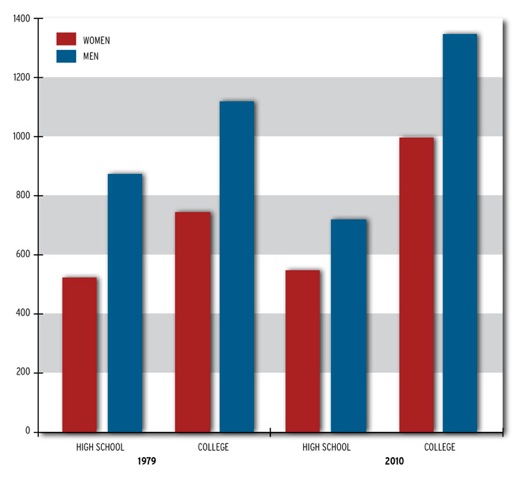March is Women’s History Month, which prompted the U.S. Census Bureau to issue a factsheet about women’s status. One of the notable facts is the number and proportion of women with a bachelor’s degree compared with the number of men.
In 2010, 30.7 million women age 25 or older had a bachelor’s degree or higher. This is slightly more than the number of men, but there are more women over age 25. Women are also more likely to be college graduates than men. Just looking at people between the ages of 25 and 34 in 2010, the percentage of women with a bachelor’s degree is higher than the percentage of men. This is true for all racial and ethnic groups, with the percentage of women with a bachelor’s degree (and no more) about 5 percentage points higher than for men in their same race and age group. The only exception is Asians between the ages of 25 and 29, where the percent with degrees is about the same for men and for women (36 percent). Asian women are also the most likely to have a college degree, while Hispanic women are least likely (about 13 percent).
Median Usual Weekly Earnings of Full-Time Workers, 25 Years and Older, Constant (2010) Dollars

statistics, table 17
What has prompted the increased educational attainment of women? No doubt there are many factors, but the economic returns are clearly one incentive. According to the Bureau of Labor Statistics, the median weekly earnings for a woman with a bachelor’s degree or higher who works full-time have increased by 33 percent in real terms since 1979. This compares with a 20 percent increase in earnings for men with the same level of educational attainment. The return for additional education is also apparent when comparing women with a college education to those with only a high school diploma. In 2010, college-educated women had weekly earnings that were 80 percent higher than the weekly earnings of high school-educated women.
Still, women have not reached equality with men. College-educated women made 74 percent of the weekly earnings of college-educated men, roughly the same gender ratio as for high school-educated workers. But it’s more than the 67 percent ratio for college-educated women in 1979. The remaining gap could be a combination of differences in occupation or industry, since women are still more likely to have jobs that pay somewhat less and, as professionals, they are more likely to be in nonprofit or public jobs.
Women have come far since 1979, closing the gap—and then some—in educational attainment, but there’s still a long way to go to shrink the gender gap in wages.
Let’s build a future where everyone, everywhere has the opportunity and power to thrive
Urban is more determined than ever to partner with changemakers to unlock opportunities that give people across the country a fair shot at reaching their fullest potential. Invest in Urban to power this type of work.